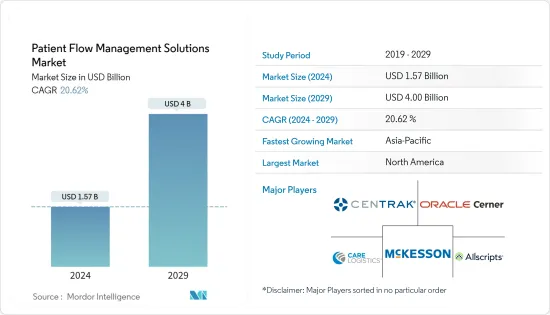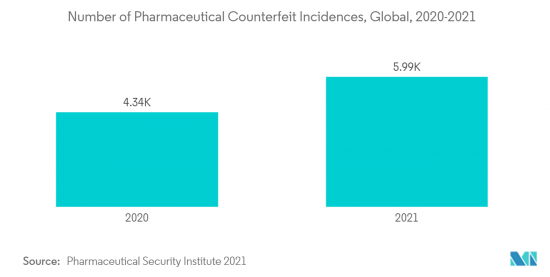
|
시장보고서
상품코드
1430553
환자 플로우 관리 솔루션 : 시장 점유율 분석, 산업 동향 및 통계, 성장 예측(2024-2029년)Patient Flow Management Solutions - Market Share Analysis, Industry Trends & Statistics, Growth Forecasts (2024 - 2029) |
||||||
환자 플로우 관리 솔루션 시장 규모는 2024년에 15억 7,000만 달러로 추정되고, 2029년에는 40억 달러에 이를 전망이며, 시장 추계 및 예측 기간(2024-2029년) CAGR은 20.62%로 성장할 것으로 예측됩니다.

팬데믹은 사람들의 삶과 일을 바꾸었습니다. 이러한 변화의 대부분은 장기적인 영향을 미칠 것으로 보입니다. 이러한 새로운 현실에 적응하기 위해 의료 업계를 포함한 모든 분야의 기업이 신기술과 작업 방법을 채택했습니다. 팬데믹 때문에 환자 플로우 관리 솔루션에 대한 수요가 크게 증가했습니다. 데일리 번들에 게재된 기사에 따르면, 2022년 7월, 봉쇄를 지원하기 위해, 병원은 팬데믹 중에 감염 환자와 접촉한 스탭을 추적 및 특정하기 위해 RFID 기술을 사용했습니다. 특히 추적 및 경보 시스템의 도입은 위험이 높은 환경에서 의료 종사자의 안전을 보장하는 데 도움이 됩니다. 또한 TechTarget에 따르면 2022년에는 70억대로 추정되었던 IoT 디바이스가 2025년에는 220억대가 될 것으로 추정되고 있습니다. 건강 관리에서 IoT 이용 사례는 기술 기반의 발전과 함께 빠르게 증가하고 있습니다. COVID-19의 대유행은 건강 관리 지출 증가라는 문제를 해결할 필요성을 높였습니다. 병원과 헬스케어 부문의 디지털 플랫폼에 대한 의존도가 높아짐에 따라 예측 기간 동안 시장은 더 나은 성장을 보일 것으로 예상되었습니다.
주요 시장 성장 요인으로는 의료비를 최소화하기 위한 부담 증대, 높은 정보 이익률(ROI)(환자 플로우 관리 솔루션 도입의 추진력), 간호 직원 및 의사 부족 등을 들 수 있으며, 솔루션에 대한 요구가 높아질 것으로 예상됩니다. 예를 들어, 커먼웰스 기금이 2021년 8월에 발표한 최신 정보에 따르면 의료비 증가는 자기 부담액과 보험료 증가에 직면한 주정부와 그 구성원들에 대해 우려하고 있습니다. 환자 플로우 관리 솔루션을 병원 EHR에 통합함으로써 이러한 일반적인 의료 시스템 문제를 기반으로 비용을 절감하기 위한 것이며 예측 기간 동안 시장 성장을 가속할 가능성 높습니다. 또한 SelectHub이 2022년 1월 발표한 기사에 따르면 보다 우수한 환자 케어와 디지털 기술을 채용한 의사나 의료기관에서 뛰어난 치료를 제공하는 편리성으로 EHR 및 EMR의 미래는 많은 가능성을 제공합니다. EHR 및 EMR의 도입률은 약 89%로 지금까지 이상으로 높아지고 있습니다. 위험 기반 관리 코드 및 수식어의 사용은 의료 현장을 괴롭히는 두 가지 문서화 문제입니다. 전문가에 따르면 환자 참여, 접근성, 규제 및 표준화가 EHR의 가장 큰 이익이 될 것입니다. 헬스케어 분야는 AI, 블록체인, 환자 플로우 관리 솔루션과 같은 기술을 통해 큰 변화를 이루려고 합니다. 이와 같이 EHR 채용이 증가하고 연결성이 높아짐을 고려하면 시장은 예측기간 동안 높은 성장을 보일 것으로 예상됩니다.
또한, 2021년 10월, 퀸즈 병원 바튼은 임상가들이 환자의 플로우를 보다 효율적으로 관리하고, 퇴원 지연을 피하고, 환자 케어를 강화하고, 중요한 능력을 확보할 수 있도록 지원하는 ExtraMed Patient Flow 시스템을 도입했습니다. 로얄 더비 병원에서 ExtraMed Patient Flow 솔루션의 성공으로 직원의 재원 일수가 단축되고 환자 케어가 강화됨에 따라 더비 대학 병원 바튼 NHS 재단 트러스트(UHDB)는 바튼 구내의 병동에 같은 시스템을 도입했습니다. 즉, 환자 플로우 관리 솔루션 시장의 성장은 환자 플로우 시스템의 이용률과 직접 연결되어 있습니다.
그러므로 예측기간 동안 시장 성장에는 위의 요인이 총체적으로 기여하는 것으로 예상됩니다. 그러나 보안 우려, 데이터 보안 침해 증가, 숙련된 IT 근로자 부족은 향후 수년간 시장 성장을 둔화시킬 가능성이 높습니다.
환자 플로우 관리 솔루션 시장 동향
실시간 위치추적 시스템 부문이 예측 기간 동안 성장할 것으로 예상
실시간 위치추적 시스템(RTLS)은 자산, 직원, 환자, 재료, 방문자 등에 무선 주파수 식별(RFID) 태그를 사용하는 정확한 위치 지정 시스템입니다. 헬스케어 시스템에서 RTLS는 비용 절감, 서비스 제공 가속화, 오류율 감소를 위해 매우 중요합니다. 이러한 기술은 환자, 의료 종사자 및 귀중한 의료기기를 추적하는 데 사용됩니다. 또한, 이러한 시스템의 기본적인 용도 중 하나는 직원과 환자의 만족도를 높이는 것입니다. 이 기술의 장점으로는 프로세스 관리, 의약품 위조 감소, 정확한 데이터 교환 등이 있습니다. 예를 들어 The Journal of Medicine Access 2022가 발표한 보고서에 따르면 영국의 의약품 및 헬스케어 제품 규제청(MHRA)에 따르면 전 세계에서 압수된 제품 중 COVID-19의 위조품이 34,000점 이상 발견되었습니다. 게다가 2021년 3월에 Journal of the American Medical Informatics Association에 게재된 논문에서는 RTLS는 프로세스와 품질 개선, 워크플로우 분석, 환자 안전 및 관리에 유용하고 효과적인 보조 방법이라고 말했습니다. 따라서 의약품 위조 증가와 RTLS의 장점으로 인해 시장은 예측 기간 동안 큰 성장을 보일 것으로 예상됩니다.
RTLS 부문의 기술 진보, 제품 출시, 제휴 및 인수 증가가 시장 성장 증가로 이어지고 있습니다. 예를 들어, 2021년 6월 임상 워크플로우 솔루션과 케어 제공을 개선하는 데이터 인사이트에 주력하는 실시간 위치추적 시스템(RTLS) 기술 제공업체의 선두인 Midmark RTLS는 클라우드 기반 블루투스 저에너지(BLE) 자산 추적 솔루션 출시를 발표했습니다. 이 솔루션은 시간이 많이 걸리는 자원 집약적 프로젝트를 수행하지 않고도 신설 및 기존에 상관없이 의료 시스템 전체에 신속하게 배포할 수 있습니다. 이러한 시장 투입이 수요 증가의 주요 요인이 될 것으로 보입니다.
게다가 2021년 8월, 헬스케어에 특화된 위치정보 및 센싱 솔루션의 세계 리더인 CenTrak은 최첨단 실내 위치정보 및 IoT 서비스 플랫폼인 Cisco DNA Spaces와 제휴했습니다. 이 CenTrak과 Cisco DNA Spaces의 통합을 통해 기존의 CenTrak 사용자는 Cisco 클라우드 형식으로 전환하여 환자 동선 관리 및 병원 자산 추적과 같은 건강 관리 산업의 시스템에서 RTLS를 완벽하게 활용할 수 있게 되었습니다.
따라서 RTLS는 많은 장점이 있으며 더 많은 제품이 등장하기 때문에 이 부문은 향후 몇 년동안 크게 성장할 것으로 예상됩니다.

북미는 환자 플로우 관리 솔루션 시장에서 큰 성장이 예상된다.
북미는 더 나은 헬스케어 인프라, 이용 가능한 기술에 관한 사람들과 헬스케어 업계 이해 관계자의 인식, 미국에 시장기업이 집중하고 있는 등의 요인에 의해 시장에서 큰 성장이 예상되고 있습니다. 예를 들어, 미국 병원 협회의 2022년 데이터에 따르면, 미국에는 6,093개의 병원이 있으며 세계의 모든 국가에서 사용 가능한 병원 수가 가장 많습니다. 이것은 미국에서 환자 플로우 관리에 대한 수요가 높다는 것을 부각하고 있습니다. 게다가 캐나다 Institute of Health Information의 National Health Expenditure Trend 2021 보고서에 따르면 캐나다의 건강 관리 지출은 2020년 3,015억 달러에서 2021년에는 3,081억 달러로 증가했습니다. 이러한 이유로, 이 지역에서는 건강 관리 비용과 정보 기술이 증가함에 따라 환자 플로우 관리 솔루션이 더 많이 사용될 가능성이 높습니다.
또한, 2022년 8월, 탬파 종합병원(TGH)은 환자의 수용, 이동, 퇴원 과정을 강화하고 환자의 경험과 효율성을 향상시키기 위해 설계된 인공지능(AI) 도구 도입에 대해 언급했습니다. TGH는 병원 내 환자 수송을 단순화하고 업무 흐름을 개선하기 위한 AI 플랫폼을 개발하고 업그레이드하기 위해 신흥 기업 Enroute와 협력했습니다. 이러한 노력은 북미에서 연구 시장의 성장을 가속할 것으로 예상됩니다.
즉, 상기 요인으로부터 조사 대상 시장은 북미에서 성장할 가능성이 높습니다.

환자 플로우 관리 솔루션 산업 개요
환자 플로우 관리 솔루션 시장은 세계 및 지역적으로 사업을 전개하는 소수의 기업의 존재로 인해 본질적으로 통합됩니다. 경쟁 구도에는 CenTrak, Inc., McKesson Corporation, Care Logistics LLC, Oracle(Cerner), Allscripts 등 시장 점유율이 뛰어나고 유명한 국제 및 지역 기업 분석이 포함됩니다.
기타 혜택 :
- 엑셀 형식 시장 예측(ME) 시트
- 3개월간의 애널리스트 서포트
목차
제1장 서론
- 조사의 전제 조건 및 시장 정의
- 조사 범위
제2장 조사 방법
제3장 주요 요약
제4장 시장 역학
- 시장 개요
- 시장 성장 촉진요인
- 헬스케어 비용 최소화를 위한 부담 증가
- 높은 ROI, 환자 플로우 관리 솔루션 도입의 추진력
- 간호 스탭 및 의사의 부족이 솔루션의 필요성을 높인다
- 시장 성장 억제요인
- 보안 우려 및 데이터 보안 침해 증가
- 숙련된 IT 전문가의 부족
- Porter's Five Forces 분석
- 신규 참가업체의 위협
- 구매자 및 소비자의 협상력
- 공급기업의 협상력
- 대체품의 위협
- 경쟁 기업간 경쟁 관계의 강도
제5장 시장 세분화
- 유형별
- 이벤트 구동형 환자 추적
- 실시간 위치 지정 시스템
- 제품별
- 통합형
- 독립형
- 배포별
- 웹 기반 및 클라우드 기반
- 온프레미스
- 컴포넌트별
- 소프트웨어
- 하드웨어
- 서비스별
- 지역별
- 북미
- 미국
- 캐나다
- 멕시코
- 유럽
- 독일
- 영국
- 프랑스
- 이탈리아
- 스페인
- 기타 유럽
- 아시아태평양
- 중국
- 일본
- 인도
- 호주
- 한국
- 기타 아시아태평양
- 중동 및 아프리카
- GCC
- 남아프리카
- 기타 중동 및 아프리카
- 남미
- 브라질
- 아르헨티나
- 기타 남미
- 북미
제6장 경쟁 구도
- 기업 프로파일
- CenTrak, Inc.
- McKesson Corporation
- Care Logistics Llc
- Oracle(Cerner)
- Allscripts
- Meditech
- GE Healthcare
- ABOUT Healthcare, Inc.
- Teletracking Technologies Inc.
제7장 시장 기회 및 앞으로의 동향
AJY 24.02.28The Patient Flow Management Solutions Market size is estimated at USD 1.57 billion in 2024, and is expected to reach USD 4 billion by 2029, growing at a CAGR of 20.62% during the forecast period (2024-2029).

The pandemic altered the way people live and work. Many of these changes would have long-term effects. As they adjusted to these new realities, companies in every area, including the medical industry, adopted new technologies and working methods. The demand for patient flow management solutions has significantly increased because of the pandemic. According to an article published in the Daily Bundle, in July 2022, to help with containment, hospitals used RFID technology to track down and identify staff members who had contact with infected patients during the pandemic. In particular, the deployment of tracking and alarm systems can help to ensure the security of medical personnel in high-risk environments. Also, according to TechTarget, in 2022, it was estimated that by 2025, there would be 22 billion linked IoT devices, up from the estimated 7 billion in 2022. The number of IoT use cases in healthcare is growing quickly as the technology base develops. The COVID-19 pandemic raised the necessity of addressing the problem of rising healthcare expenditures. The market was expected to show better growth during the forecast period due to the increasing dependency of hospitals and the healthcare sector on digital platforms.
The major market growth factors include the growing burden to minimize healthcare costs, a high return on information (ROI) (an impetus to install patient flow management solutions), and a shortage of nursing staff and doctors, which will increase the need for solutions. For instance, as per the August 2021 update from the Commonwealth Fund, rising healthcare expenditure concerns state governments and their constituents, who are facing greater out-of-pocket costs and premiums. By integrating patient flow management solutions into EHRs in hospitals, expenses are intended to be reduced based on these common health system issues, which is likely to boost the growth of the market over the forecast period. Furthermore, as per an article published by SelectHub in January 2022, with more excellent patient care and the convenience of delivering superior treatment with doctors and medical institutions employing digital technologies, the futures of EHR and EMR offer a lot of potential. At roughly 89%, EHR/EMR adoption rates are higher than ever. Risk-based management codes and the usage of modifiers are two documentation difficulties that continue to worry medical practices. According to experts, patient participation, accessibility, regulation, and standardization will see the biggest gains in the EHR. The healthcare sector is about to undergo significant transformation because of technologies like AI, blockchain, and patient flow management solutions. Thus, considering the rising adoption of EHR and connectivity, the market is expected to witness high growth over the forecast period.
Furthermore, in October 2021, Queen's Hospital Burton deployed the ExtraMed Patient Flow system to help clinicians more efficiently manage patient flow, avoid delays in discharge, enhance patient care, and free up crucial capacity. Following the success of the ExtraMed Patient Flow solution at Royal Derby Hospital, where staff reduced lengths of stay and enhanced care for patients, the University Hospitals of Derby and Burton NHS Foundation Trust (UHDB) rolled out the same system in wards across its Burton site. So, the growth of the patient flow management solutions market is directly tied to the rate at which patient flow systems are being used.
Therefore, the factors mentioned above are attributed collectively to the studied market's growth over the forecast period. But worries about security, a rise in data security breaches, and a lack of skilled IT workers are likely to slow market growth over the next few years.
Patient Flow Management Solutions Market Trends
Real-Time Locating Systems Segment is Expected to Witness Growth Over the Forecast Period
A real-time location system (RTLS) is an exact positioning system that uses radio frequency identification (RFID) tags on assets, employees, patients, materials, or visitors. In healthcare systems, RTLS is crucial because it lowers costs, speeds up the delivery of services, and reduces error rates. These technologies are used to track patients, medical personnel, and priceless medical equipment. Additionally, one of the fundamental uses of these systems is to increase staff and patient satisfaction. Positive features of this technology include control over processes, reduced pharmaceutical counterfeiting, and accurate data exchange. For instance, according to a report published by The Journal of Medicine Access 2022, more than 34,000 counterfeit COVID-19 items were found among the products confiscated globally, according to the Medicines and Healthcare Products Regulatory Agency (MHRA) of the United Kingdom. Additionally, an article published in the Journal of the American Medical Informatics Association in March 2021 stated that RTLS is a useful and effective adjunct methodology in process and quality improvement, workflow analysis, and patient safety and management. Thus, with the increase in pharmaceutical counterfeiting and the advantages of RTLS, the market is expected to show significant growth over the forecast period.
The increasing technological advancements, product launches, partnerships, and acquisitions in the RTLS segment are leading to an increase in market growth. For instance, in June 2021, Midmark RTLS, a leading real-time locating system (RTLS) technology provider focused on clinical workflow solutions and data insights that improve the delivery of care, announced the launch of a cloud-based, Bluetooth low energy (BLE) asset tracking solution. This solution can be quickly deployed across health systems in both new and existing facilities without time-consuming, resource-intensive projects. Such launches are likely to be the primary factor driving their increasing demand.
Furthermore, in August 2021, CenTrak, a global leader in healthcare-specific locating and sensing solutions, partnered with Cisco DNA Spaces, a cutting-edge indoor location and IoT services platform. This integration of CenTrak and Cisco DNA Spaces allowed existing CenTrak users to migrate to Cisco's cloud format to take full advantage of RTLS in a system in the healthcare industry for patient flow management and hospital asset tracking.
So, because RTLS has a lot of benefits and more products are coming out, this segment is expected to grow a lot over the next few years.

North America is Expected to Have Significant Growth in the Patient Flow Management Solutions Market
North America is expected to have significant growth in the market owing to factors such as better healthcare infrastructure, awareness among people and healthcare industry stakeholders about available technologies, and the high concentration of market players in the United States. For instance, according to the American Hospital Association's data for 2022, there were 6,093 hospitals in the United States, among the highest number of hospitals available in all countries of the world. This highlights that the demand for patient flow management is high in the United States. Furthermore, according to the National Health Expenditure Trend 2021 report from the Canadian Institute of Health Information, Canadian health expenditure increased to USD 308.1 billion in 2021 from USD 301.5 billion in 2020.Because of this, the region is likely to use more patient flow management solutions as healthcare costs and information technology go up.
Additionally, in August 2022, Tampa General Hospital (TGH) mentioned the implementation of an artificial intelligence (AI) tool designed to enhance the processes of admitting, moving, and discharging patients to improve patient experience and efficiency. TGH collaborated with startup Enroute to create and upgrade an AI platform to simplify patient transportation within hospitals and improve operational flow. Such initiatives are projected to drive the growth of the studied market in North America.
So, because of the above factors, it is likely that the studied market will grow in the North American region.

Patient Flow Management Solutions Industry Overview
The patient flow management solutions market is consolidated in nature due to the presence of a few companies operating globally as well as regionally. The competitive landscape includes an analysis of international and local companies that hold market shares and are well known, including CenTrak, Inc., McKesson Corporation, Care Logistics L.L.C., Oracle (Cerner), and Allscripts, among others.
Additional Benefits:
- The market estimate (ME) sheet in Excel format
- 3 months of analyst support
TABLE OF CONTENTS
1 INTRODUCTION
- 1.1 Study Assumptions and Market Definition
- 1.2 Scope of the Study
2 RESEARCH METHODOLOGY
3 EXECUTIVE SUMMARY
4 MARKET DYNAMICS
- 4.1 Market Overview
- 4.2 Market Drivers
- 4.2.1 Growing Burden to Minimize the Healthcare Cost
- 4.2.2 High ROI, An Impetus To Install Patient Flow Management Solutions
- 4.2.3 Shortage of Nursing Staff & Doctors Will Increase The Need For Solution
- 4.3 Market Restraints
- 4.3.1 Security Concerns, Rising Incidences Of Data Security Breach
- 4.3.2 Lack of Skilled IT Professionals
- 4.4 Porter's Five Forces Analysis
- 4.4.1 Threat of New Entrants
- 4.4.2 Bargaining Power of Buyers/Consumers
- 4.4.3 Bargaining Power of Suppliers
- 4.4.4 Threat of Substitute Products
- 4.4.5 Intensity of Competitive Rivalry
5 MARKET SEGMENTATION (Market Size by Value - USD Million)
- 5.1 By Type
- 5.1.1 Event-Driven Patient Tracking
- 5.1.2 Real-Time Locating Systems
- 5.2 By Product
- 5.2.1 Integrated
- 5.2.2 Standalone
- 5.3 By Deployment
- 5.3.1 Web-Based and Cloud-Based
- 5.3.2 On-Premise
- 5.4 By Component
- 5.4.1 Software
- 5.4.2 Hardware
- 5.4.3 Services
- 5.5 Geography
- 5.5.1 North America
- 5.5.1.1 United States
- 5.5.1.2 Canada
- 5.5.1.3 Mexico
- 5.5.2 Europe
- 5.5.2.1 Germany
- 5.5.2.2 United Kingdom
- 5.5.2.3 France
- 5.5.2.4 Italy
- 5.5.2.5 Spain
- 5.5.2.6 Rest of Europe
- 5.5.3 Asia-Pacific
- 5.5.3.1 China
- 5.5.3.2 Japan
- 5.5.3.3 India
- 5.5.3.4 Australia
- 5.5.3.5 South Korea
- 5.5.3.6 Rest of Asia-Pacific
- 5.5.4 Middle East and Africa
- 5.5.4.1 GCC
- 5.5.4.2 South Africa
- 5.5.4.3 Rest of Middle East and Africa
- 5.5.5 South America
- 5.5.5.1 Brazil
- 5.5.5.2 Argentina
- 5.5.5.3 Rest of South America
- 5.5.1 North America
6 COMPETITIVE LANDSCAPE
- 6.1 Company Profiles
- 6.1.1 CenTrak, Inc.
- 6.1.2 McKesson Corporation
- 6.1.3 Care Logistics Llc
- 6.1.4 Oracle (Cerner)
- 6.1.5 Allscripts
- 6.1.6 Meditech
- 6.1.7 GE Healthcare
- 6.1.8 ABOUT Healthcare, Inc.
- 6.1.9 Teletracking Technologies Inc.













